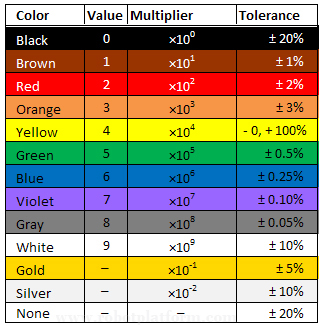Resistor Color Codes

Resistor Values are always coded in Ohms (Ω) and they usually have 4 or 5 color bands printed on it. The first two bands represent the value of the resistor with each band giving the base number. The third and forth band represents the multiplier and tolerance respectively. If the resistor has a 5th band, then it provides more precise value as the first three bands represent the base value, 4th the multiplier and the last one signifying the tolerance. If you rarely come across a resistor with 6 bands, then it is similar to resistor with 5 bands and the 6th band representing the thermal co-efficient.
Now let us see how we calculate resistor value using this table. First count the number of bands on the resistor. Then find the tolerance band which will be either Silver or Gold. Now starting from the other end, note down the numbers specific to the color codes as per the table given above.
Assume that we have a resistor with 4 bands as per the picture. As per the table above:
![]()
Red denotes 2
Blue denotes 6
Violet denotes 7
Gold denotes ± 5%
Here, first two bands represent the value. i.e. 26. Violet represent multiplier 7, which is equal to x107. Gold representing tolerance has a value of ± 5%. This means we have a resistor of 26 x 107 Ohms (260MΩ) with a tolerance ± 5%. (This example is for illustration purpose and you may not find a resistor with this value. Read further to know about resistor values). Similarly, you can calculate the value of a resistor for any resistor with 5 or 6 bands.
I found a few Mnemonics over the web for remembering the color codes.
- Bright Boys Rave Over Young Girls But Veto Getting Wed
- Bad Boys Ravish Only Young Girls, But Violet Gives Willingly
- B B ROY goes to Great Britain to find a Very Good Wife (My all time favorite for no reason)
There is another variation of resistors known as the Surface Mount Resistors. These resistors are really small rectangular resistors with leads which help in soldering it directly over a circuit board. Made of metal oxide film, these SMD’s (commonly known) can be produced with very low tolerance which means highly precise results.
 Although resistors come in different forms, they can be briefly categorized into two types. Fixed type and Variable type resistors. We have already discussed about fixed type resistors above. Variable type resistors, also called Potentiometers (or Pots) are cylindrical shape devices with three terminals and a sliding contact in between. If you have ever increased or decreased volume in those old radios, you have already used a Pot. Twisting the cylindrical pole would increase or decrease resistance. There are also linear Potentiometers which serve the same purpose, with the only difference that you slide to change resistance rather than rotate it. There are also trimmers available which are miniature Pots that can directly be mounted on PCB and best used when you do not need frequent changes in resistance values.
Although resistors come in different forms, they can be briefly categorized into two types. Fixed type and Variable type resistors. We have already discussed about fixed type resistors above. Variable type resistors, also called Potentiometers (or Pots) are cylindrical shape devices with three terminals and a sliding contact in between. If you have ever increased or decreased volume in those old radios, you have already used a Pot. Twisting the cylindrical pole would increase or decrease resistance. There are also linear Potentiometers which serve the same purpose, with the only difference that you slide to change resistance rather than rotate it. There are also trimmers available which are miniature Pots that can directly be mounted on PCB and best used when you do not need frequent changes in resistance values.
Resistor Values:
If you have ever worked on circuits, then you should have faced the difficulty in not finding resistor with every possible value. This is because if manufactures make every possible value, then it would make insensible. Hence they follow two different standards, E6 series and the E12 Series.
E6 Series: Here there manufacture resistors with 6 different values from 0 to 100 and then multiples of ten for those values with tolerance of 20%. 10, 15, 22, 33, 47, 68 and their multiples of 10 like 100, 150, 220, 330, 470, 680….2.2K, 3.3K… Here you can notice that next value is almost equal to have the previous value. (Half of 10 is 5, so 10+5 = 15, half of 15 being almost 7, 15+7= 22, etc.)
E12 Series: In this series, there are 12 values from 0 to 100 and their multiples of 10 with a tolerance of 10%. 10, 12, 15, 18, 22, 27, 33, 39, 47, 56, 68, 82 and their multiples of 10 like 100, 120, 150….
There are also other standards available like the E24 and E96 series with 5% and 1% tolerance. However it just means that there are more values between values in E6 and E12 series.
So, what if we need resistors of exact value? In that case we can use a Potentiometer; However Pots, which is quite costly. The work around is to use resistors in series or parallel. Also resistors do not occur in isolation in any circuit and will always be a part of larger circuit which consists of many resistors in a series or parallel combination or both.
Do you have anything to say?
Visit the Forum to discuss, learn and share anything related to robotics and electronics !!








